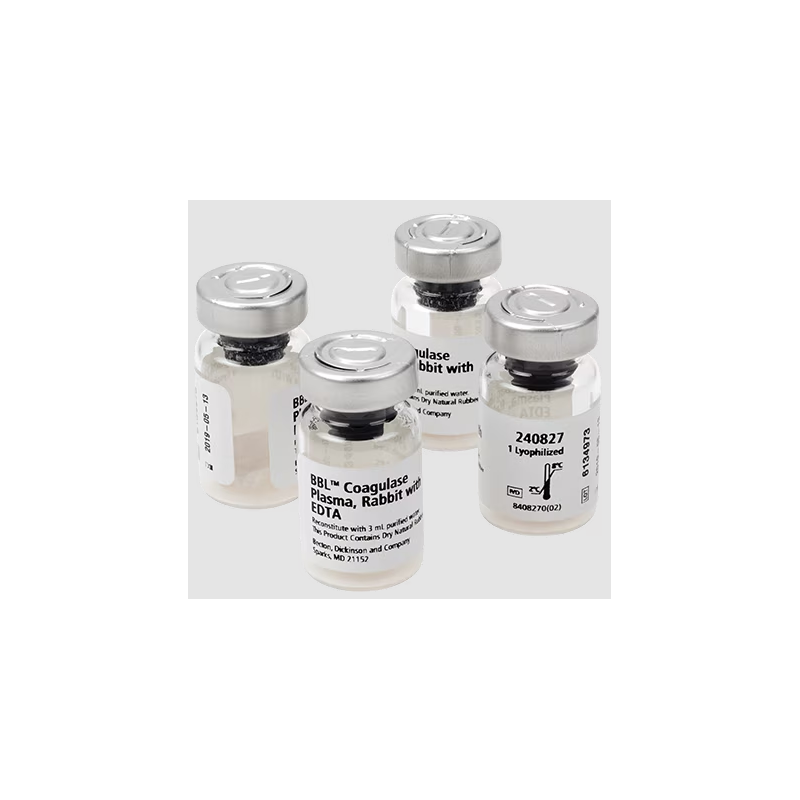



BD BBL Coagulase Plasma Rabbit with EDTA, Pk of 10 x 3mL (requires reconstitution). Refrigerate on arrival between +2 and +8 Celsius.
BD Catalog No. 240827
 Security policy
Security policy
We do not sell customer sales data.
 Delivery policy
Delivery policy
Orders are generally shipped within 1 business day after receipt of payment, Monday through Friday.
 Return policy
Return policy
Sterile items cannot be returned. All other items must receive a return authorization in writing.
Coagulase Plasma Rabbit, with EDTA, lyophilized; reconstitutes to 3.0 mL for Direct Tube Method
BD BBL Catalog 240827
INTENDED USE BBL™ Coagulase Plasma, Rabbit and BBL Coagulase Plasma, Rabbit with EDTA are used to qualitatively determine the pathogenicity of staphylococci using the direct tube method.
SUMMARY AND EXPLANATION Identification of staphylococci is based on microscopic examination, colonial morphology and cultural and biochemical characteristics. Staphylococci associated with acute infection (Staphylococcus aureus in humans and S. intermedius and S. hyicus in animals) can clot plasma. The most widely used and generally accepted criterion for identification of these pathogenic organisms is based on the presence of the enzyme coagulase. The ability of Staphylococcus to produce coagulase was first reported by Loeb in 1903.
Coagulase binds plasma fibrinogen, causing the organisms to agglutinate or plasma to clot. Two different forms of coagulase can be produced, free and bound. Free coagulase is an extracellular enzyme produced when the organism is cultured in broth. Bound coagulase, also known as clumping factor, remains attached to the cell wall of the organism. The tube test can detect the presence of both bound and free coagulase. Isolates that do not produce clumping factor must be tested for the ability to produce extracellular coagulase (free coagulase).
BBL Coagulase Plasma, Rabbit and BBL Coagulase Plasma Rabbit with EDTA are recommended for performing the direct tube test. The inoculum used for testing must be pure because a contaminant may produce false results after prolonged incubation. For the coagulase test, BBL Coagulase Plasma, Rabbit with EDTA is superior to citrated plasma because citrate-utilizing organisms such as Pseudomonas species, Serratia marcescens, Enterococcus faecalis and strains of Streptococcus will clot citrated plasma in 18 h.
PRINCIPLES OF THE PROCEDURE S. aureus produces two types of coagulase, free and bound. Free coagulase is an extracellular enzyme produced when the organism is cultured in broth. Bound coagulase, also known as the clumping factor, remains attached to the cell wall of the organism. In the direct tube test, free coagulase liberated from the cell acts on prothrombin in the coagulase plasma to give a thrombin-like product. This product then acts on fibrinogen to form a fibrin clot. The tube test is performed by mixing an overnight broth culture or colonies from a non-inhibitory agar plate into a tube of rehydrated coagulase plasma. The tube is incubated at 37 °C. The formation of a clot in the plasma indicates coagulase production.
REAGENTS Coagulase Plasma, Rabbit is lyophilized rabbit plasma with 0.85% sodium citrate and 0.85% sodium chloride, approximately. Coagulase Plasma, Rabbit with EDTA is lyophilized rabbit plasma with 0.15% EDTA (ethylenediaminetetraacetic acid) and 0.85% sodium chloride, approximately.
Specific References